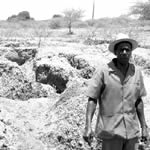Erosion stalls Gudyanga irrigation development

An old man looks at himself in the clouded mirror above the mantelpiece, surprised at his greying temples and the lines of weary tension in his features.
Wiry, hairy and seemingly spent off, the old man considers the past, present and future, as it dawns on him that time has moved.
Life has not been very kind to him.
He is raggedly dressed, thin to the point of emaciation, his teeth stained due to neglect. But a survivor’s hope flashes in his eyes and, a last chance smile strains his old face.
Years of deprivation and under-feeding have left an indelible mark on his body, but he had a strong resolve to soldier on.
His biggest worry at the moment is whether his maize and sorghum crops would make it in the wake of the very dry and hot weather in the region.
The previous harvest has been meager, so was that of the preceding year and that of the years that came first.
Life has become a perennial stru- ggle.
It is mid-summer, but in Gudyanga Village of Chimanimani District, a spitting distance from Nyanyadzi’s Hot Springs in Manicaland Province, there is very little green matter in the fields to show for it.
The few crops that have managed to make it beyond knee-height are beginning to show signs of severe moisture stress.
The villagers have long given up on making rain ceremonies or prayer and have naturally come to terms with the fact that they are located in natural regions 4 and 5 where aridity is the order of the day.
The only way out is to turn to irrigation.
And, this has been the area’s biggest ambition since 1997 when its neighbours – Nyanyadzi to the South and Tonhorai to the North got the irrigation reprieve, courtesy of the European Union.
Villages such as Chibuwe and Maunganidze were fortunate to have irrigation infrastructure developed and the villagers now proudly talk of “kumaacre” (the acres), referring to the small portions under irrigation.
They grow different crops ranging from maize, wheat and groundnuts to horticultural ones such as tomatoes and leaf vegetables and they earn decent incomes from there.
They use water that flows by gravity from rivers Nyanyadzi and Changadzi or sometimes from the neighbouring mountains.
They do not have any irrigation costs except for maintenance services.
Gudyanga lies between these two localities and a stretch of about 10 kilometres is still under dryland agriculture that has become even more difficult due to global warming.
“This stretch between Nyanyadzi and Tonhorai has been earmarked for irrigation development since 1997.
“Nothing has been done to date and running water has since scrapped the topsoil creating numerous gullies that now need to be covered before anything meaningful can happen, the old man, Quitani Mubengo said recently.
Mubengo added that instead of committing themselves to agriculture, weaving mats and carpentry had become their biggest occupations from which they earned some income to buy grain from other areas, Tonhorai and Nyanyadzi included.
After saying this, old Mubengo stretched his listless body, belched loudly before staring vacantly across his lifeless field.
His gaze wandered to the main road linking Mutare and Birchenough and briefly settled on the numerous mirages that seemed to be drowning the hot asphalt, all thanks to the blistering sun.
Just across the road is the portion of land that had been earmarked for the development of the irrigation scheme.
The old man is obviously rapped in thought and does not even notice headman Gudyanga’s son arrive from the development meeting that had been called to discuss the irrigation issue.
After briefing him on the outcome of the meeting, the duo head towards headman Gudyanga’s homestead whom they find sitting under the shade of a very big tree growing in his yard.
Another villager joins them.
The headman’s son, Witness, informs them that the village in fact needed bulldozers to fill up gullies before irrigation pipes could be installed, that is, if a donor or the Government could be persuaded to do the task.
The group seems to be at a loss for words. The irrigation issue has always been contentious among the villagers.
There are three villages under headman Gudyanga with more than 500 households, the majority of whom now trade their labour for food from those with better climatic conditions or irrigation facilities.
“People from these villages can travel as far as Chipinge, Mutare, Harare and Masvingo to sell their wares and later buy grain.
“In some cases, they do barter trading and just bring home grain to feed their families.
“Many people have now switched to small grain crops like sorghum, rapoko and millet, but they too can withstand the blistering sun to a certain extent.
“When it goes beyond that as is currently happening, they also wilt and die,” headman Gudyanga commented.
But the villagers in the area do not have the harsh climate only to blame.
Brick moulders have also significantly contributed to the environmental degradation resulting in the numerous gullies that now seriously affect the landscape.
“They cut trees to use as fuel for curing their bricks and as you can see near the shops there, there are mounds of unused bricks that were cured using firewood.
“In this case, we cannot blame the adverse weather because it never cleared trees that are supposed to hold the soil together under normal circumstances. But, it is people who are doing so,” Mubengo chipped in.








Comments